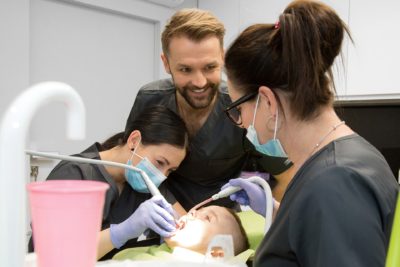Our specialists:

Lek. dent. Piotr Papiór
SPECIALIST IN CONSERVATIVE DENTISTRY AND PROSTHETICSLek. dent. Piotr Nadolski
GENERAL DENTISTRY, MICROSCOPIC ENDODONTICS
Conservative dentistry deals with the treatment and prevention of cavities – a bacterial disease of the oral cavity with which the vast majority of society struggles with at some point. Preventing the development of carious lesions is an integral part of caring for one’s teeth. Thanks to painless treatments in the field of conservative dentistry, patients can keep their teeth in perfect condition for many years.
The development of cavities consists in the gradual decomposition of the hard tissues of the tooth. This process is caused by plaque-forming bacteria that accumulate on the teeth of every person. It is worth noting that these deposits can be removed by yourself through proper oral hygiene – brushing, flossing, rinsing – while the removal of tartar (mineralized plaque) requires the intervention of a dentist.
The first stage of the development of carious lesions is manifested by white spots on the surface of the enamel – this means demineralization, i.e. a loss of mineral components. To remove them, improve hygiene habits are often sufficient, and local remineralisation or the use of resin impregnation with ICON as a remedy – there is no need to intervene with a drill.
Further neglect leads to the formation of carious cavities – it is necessary to remove infected and damaged tooth fragments and fill the tooth. In extreme cases, the pulp becomes infected – carious bacteria attacks the pulp and causes its irreversible inflammation. In such situations, conservative dentistry requires endodontic support.
Tooth filling
After conservative treatment, it is necessary to rebuild the cavities by using a composite filling using the layered method, which will most closely recreate the natural enamel of your own teeth. Its use protects the tooth against the further development of disease and enables restoration of the functionality and aesthetics of the teeth. This solution is used for small cavities – as an alternative in the case of greater tooth damage, among others, prosthetic crowns or onlays.
Teeth varnishing
Teeth varnishing is a procedure that strengthens the enamel by introducing a large dose of fluoride ions. Due to the direct contact of the varnish with the tooth surface, its structure is immediately rebuilt – it becomes more durable, more resistant to cariogenic bacteria and acids. In this way, the risk of cavities is significantly reduced. It is worth mentioning that this conservative dentistry procedure is painless, so we recommend it as part of a child’s visit.
Due to the similarity of names, varnishing is often confused with sealing. The fact is that both treatments are designed to prevent the development of cavities, but the sealing procedure is based on the protection of furrows and gaps that are difficult to clean, where plaque could accumulate.
ICON infiltration
An alternative to the removal of initial cavities – white spots that often occur after the removal of the fixed appliance, in young people, when the teeth are not fully mineralized, or in the case of dental fluorosis, an ICON infiltration. A special resin penetrates the structure of the enamel and strengthens it from the inside and reduces white spots.
Aesthetic reconstruction of the front teeth
Thanks to the use of composites with ceramic nanofillers and a layered application technique, we effectively rebuild damaged front teeth, achieving an effect similar to our own teeth. In the case of Digital Smile Design (DSD), we use the Injection Molding technique – direct reconstruction with a composite material, which we inject into a mold placed on the teeth, prepared on the basis of a wax model.
The above method enables the non-invasive improvement of smile aesthetics within a reasonable budget. We recommend this solution before applying all-ceramic veneers – aesthetic reconstruction of the front teeth allows you to “test” a new smile without interfering with the tooth structure. The effect obtained is completely reversible.
